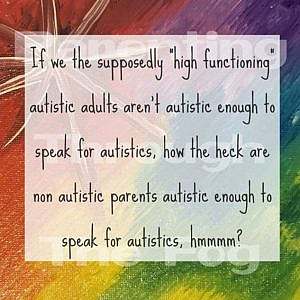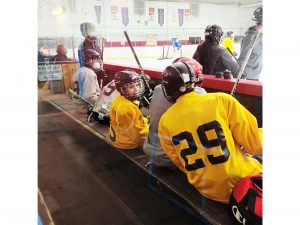Is ABA abuse or are activists pawns in a larger game?
ABA or Applied Behavioural Analysis, is autism’s most common therapy. It’s not without controversy. Some people really hate ABA. In one corner, parents of autistic children are fighting for clinically supervised core services, including ABA. In the other, a group of autistic self-advocates are passionately working to see ABA eliminated entirely.
The conflicts can be bitter. They can be personal. They can fracture a community. And in the wings, the Ford government used them to their full advantage to dilute clinical services and make even fewer supports available.
What is ABA?
There are many programs that fall under the umbrella of ABA but in essence, life skills are assessed, tracked and broken down into small manageable steps for the learner. Children are incentivised and rewarded along the way to encourage continued success.
Instructor therapists teach everything from social skills and school readiness, to using the bathroom, to eating a meal, to getting dressed. The goals are to build up a child’s abilities and confidence to meaningfully integrate within family, school and community life. Centres act as a launching pad for kids who need more time to learn. These are things many take for granted but that can seem insurmountable for families to teach and autistic children to learn.
The dissenters
ABA’s most vocal opponents are often autistic self-advocates who feel it is an abusive practice that trains Pavlovian responses and denies autistic people acceptance, inclusion, and accommodation as their authentic selves.
Pavlovian responses and denies autistic people acceptance, inclusion, and accommodation as their authentic selves.
Some self-advocates take aim at parents fighting for ABA services for their kids and target them on social media. When you’re dedicated to your child, it’s a shock the first time you read something like these comments that slams you or the services you seek:
“Moms who use their child’s autism for clout and pity see themselves as animal handlers, not parents.”
“A great strategy would be ending the platforms for con artists calling themselves ‘autism parents’ pretending to SPEAK ON BEHALF OF US!”
“I hope your children all die under Ford. Maybe that will give you a fucking wake-up call”
It can be pretty uncomfortable.
I understand why some people hate ABA. I had a really bad taste in my mouth too. In 2015, after waiting 2.5 years for a placement with our local provider for my son, we arrived at an unwelcoming scene with unhappy workers and a blaring PA system that was immediately triggering of my son’s auditory hyper-sensitivities. It was so profoundly upsetting that seven years later I wrestle with those memories.
The centre was the only one available to us. Its operators were accustomed to running their show their way, and their authority was intractable. I see myself as a reasonable person willing to work on solutions. But if I raised concerns, the answer was, “You know where the door is.” I was also threatened by the possibility that if we left, our funding would be revoked. I learned later that this was a lie. Weighing what could be gained for my son versus the distress the centre caused him, I navigated it as best I could; I took him to a new provider far from home to see if this therapy, in spite of its rigid leadership, could help him.
There’s an important difference between me and self-advocates struggling with memories of their own experience with ABA. I could take in the scene and if I did not like something, I had the power to put a stop to it. Children can’t. Some self-advocates liken ABA to conversion therapy rooted in compelling compliance with a neurotypical world when what they seek is a world that accepts them as they are. As one self-advocate put it:
Building bridges
In my six-year stint (2016-2022) as an executive member of the Ontario Autism Coalition (OAC), I was known as the peacemaker. Dubbed the “outreach” lady, I spent hours on our Facebook page reading through disputes. When flare-ups occurred, people became accustomed to and probably annoyed by my waving the flag of truce and reminding our members to keep their eyes on the prize of a world in which everyone’s needs were met.
The OAC is a kitchen table, nonpartisan organization that excels at getting the big meetings with decision makers and bureaucrats. You will never meet more articulate, well informed people when it comes to the politics of autism in our province. Our Facebook page was our calling card but it is also where we found our brain trust.
We fought a battle in 2016 when the previous government proposed changes that would stop funding for services when a child reached the age of five. Many kids hadn’t even received a diagnosis by that age. The proposed new program was framed as an infusion of new funds into the system, but would have left tens of thousands of kids with nothing.
Social media helped us surge and gain thousands of followers. Our public demonstrations were large, loud, and presented a unified front. Ultimately, we won and the government backed away from the proposed program, offering funding with no age-restriction to the age of 18 for a variety of supports, including ABA. It was a great victory for us, but of course the situation was still far from perfect. It served some very well, some moderately and others, not at all. As with all advocacy work, you take your wins where they come. But behind the scenes, there was a battle happening within the OAC community itself. The more we succeeded in our fight with the government, the more ABA detractors hammered on our gates.
I became acquainted with a lot of self-advocates via social media over this period. They had valid questions like: “Why do you call yourselves a coalition when you don’t work on adult issues?” They had me there. These interactions cut me to the quick. In fighting to save my son’s incredible ABA program, I had walked headfirst into a circle of people who were hurt and angry and who felt unheard and excluded. I did too. It was a painful time.
Therapists from other disciplines joined in too, seeming to believe that a fight to save one service was somehow a rejection of the value of others. Other voices, like those of parents who had opted out of ABA services, and those who had never set foot in a full-time centre, joined in to denounce the ills of ABA and attack parents advocating for it.
 Jim Sinclair’s 2012 article, “Don’t Mourn for Us”, provides some insight into the views of some autistic people. Lucy Kross Wallace’s insightfully brave confession, “The Cognitive Distortions that Feed Neurodiversity Radicalism” is also an important read. The contrast between the positions can be stark and the divide deep.
Jim Sinclair’s 2012 article, “Don’t Mourn for Us”, provides some insight into the views of some autistic people. Lucy Kross Wallace’s insightfully brave confession, “The Cognitive Distortions that Feed Neurodiversity Radicalism” is also an important read. The contrast between the positions can be stark and the divide deep.
As a mom, I am keenly aware that a self-advocate could be my friend’s child or even my son one day. I understand the passion and urgency from both camps and believe the tone we use must stay civil if we are to succeed as a community. That’s hard to do when there is so much at stake.
Diluting Clinical Services
The Ford government took full advantage of families who were still in that early stage of learning about the diagnosis, the therapies, and their own children. In 2018, it secretly froze the waitlist for funded services. The waitlist freeze was a crafty way to further divide advocates. Families with a recent diagnosis were never told what was available before, and so didn’t know what they were missing. And, while an early diagnosis can be key, no one can predict how a child will develop or how much support they may need at that stage.
In Feb 2019, in one fell swoop the government erased 20 years of infrastructure by implementing tiny increments of age-based flat rate funding. It was a fatal blow. Chronically underserviced communities in Northern Ontario saw their services shut down. Parents who had insight into the problem were enraged by the Ford government’s decision, while many families not yet familiar to the game, were relieved just to get any support at all. From the Ford government perspective, this was a useful division of its opposition. It was then that I discovered I was not alone in monitoring the battles on our Facebook and twitter pages. We were being watched.
Having manufactured the crisis, the Ford government assembled a panel of experts, parents and self-advocates to form a recommendations committee. Guess who was invited to join it? The very same self-advocates who had battled online with OAC parents on our social media pages. Guess who was not? Our resident expert and one of the most effective advocates for autism supports in the province; OAC founding member Bruce McIntosh, who had earlier resigned his role as a Queen’s Park staffer over the Ford government’s autism plan.
Furthermore, in 2019, the rumour mill churned over the Ford government’s suspected bolstering of anti ABA

organization Autistics for Autistics Ontario (A4A). A4A is group working to neutralize opposition to the Ford government’s program changes. Ford-friendly conservative media consultants, Daisy Consulting Group provided free media training to A4A. The plot thickens as back in 2018 (the year of the waitlist freeze) Daisy had contracts to provide strategic advice to the Ontario government. Daisy Consulting claimed that those were unconnected to their 2019 volunteer work for A4A.
Then, in 2020, the government used COVID shutdowns to restrict access even more. Instead of funding therapies with a trained professional, it waitlisted parents who were offered $5000 cheques to purchase toys, trampolines and pools. Anything deemed “therapeutic” qualified as an expense.
The battles on our social media pages were never uglier. As a result, the OAC ended up fielding hundreds of inquiries about how to interpret spending allocations. We watched as all the work we did in 2016 to ensure the funding of clinical services turned to waste right before our eyes.
Autism services today
Today’s battle to save Autism Services is an out-of the frying pan and into- the-fire disaster. We moved from a clunky one size fits all system that serviced some really well, let some down and neglected others entirely to blowing the whole program to smithereens so everyone is left out. Since the Ford government’s revamp of the Ontario Autism Program, the waitlist for core funding has more than doubled, with more than sixty thousand children waiting for therapy in a province riddled with service deserts where the nearest provider may be many hours’ drive away.
And it doesn’t stop with direct supports. The recent Ontario budget notes a 47 million reduction in funding for education. How much of that will cut the already inadequate support for special education programs in public schools? A perfect storm has been created for autistic children to be set up to fail. There’s no fat to cut and there never was, but the Ford government continues to hack through the bone and deep into the marrow.
The online battles rage on as self-advocates seem to have missed the memo that fierce opposition to ABA translates into loss of government support for any service for autistic kids. It will take decades to rebuild services in Ontario.
The impact on families
 My friend Fadyaa’s* 12-year old son is one of the 60,000 waiting for therapeutic interventions. Ahmed* cannot brush his teeth, comb his hair, dress himself or use the toilet. He refuses all food except bread and crackers. His teeth are rotten and he has chronic constipation. Able to run like the wind, climb and grab anything in a flash, his safety is always at risk. Ahmed is attracted to the feel of water or any liquid. He is also drawn to heat sources such as heaters, hot air registers, the stove, a hot iron, and lit candles. His loving family with two parents and six children provide round the clock care for Ahmed and do all they can to keep him safe.
My friend Fadyaa’s* 12-year old son is one of the 60,000 waiting for therapeutic interventions. Ahmed* cannot brush his teeth, comb his hair, dress himself or use the toilet. He refuses all food except bread and crackers. His teeth are rotten and he has chronic constipation. Able to run like the wind, climb and grab anything in a flash, his safety is always at risk. Ahmed is attracted to the feel of water or any liquid. He is also drawn to heat sources such as heaters, hot air registers, the stove, a hot iron, and lit candles. His loving family with two parents and six children provide round the clock care for Ahmed and do all they can to keep him safe.
Last month, Ahmed set himself on fire. It happened in just a moment. He sustained second degree burns all over his chest, his hands and under his armpits. He’s since had two skin graft surgeries.
Ahmed’s therapy was discontinued at age six. It was the same centre we removed our son from. With no clinician in sight, admins were given the power to decide when a child had reached the end of their program, and thus the end of treatment and ABA funding. There was no place left but school for him. Like many immigrant second language speaking parents tricked out of service, Ahmed’s mom found herself at the schoolhouse door with a child unable to communicate or self-regulate.
Ahmed is far from thriving at school. Despite their best efforts, neither his teacher nor his education assistant have been able to engage him. By 11:00 a.m. the school calls mom to come and get him because he’s wandering the halls or creating a disturbance. She takes him home and feeds him the lunch she packed for the day. Since by then there is so little time left in his school day, he will often remain at home for the rest of the afternoon. This is not education. Once he came home from school with his sleeves sewn shut.
The contrast between articulate self-advocates and my buddy Ahmed couldn’t be starker. They have a diagnosis of autism in common but it pretty much ends there. Fadyaa has been and will be caring for Ahmed until she drops, never resting for fear of what he will get into next.
When caring for a severely affected child, your life gets small really fast. I know this because I had a young son with complex needs. I say “had” because my son successfully attended a clinically supervised ABA program. On our second go at a new centre, we fashioned an individualized program but the core service was behavioural intervention rooted in the principles of ABA.
What ABA did for us
No provider worth their salt will make promises as to what a child’s outcome will be with ABA. Every kid is unique and so each needs an individualized treatment plan.
But it was life changing for my son. With ABA, a boy who was assessed at age four as below the first percentile in all domains can now do and delight in dozens of accomplishments. Here is a small sample of what he has mastered:
-
- Toileting, brushing teeth, dressing, hygiene and feeding himself.
- Self-regulation
- Works easily within a classroom setting, and takes direction from his instructors
- Answering questions and taking an active part in conversations, playing all sorts of games with friends and family
- Attending field trips, waiting in line, and staying with a group
- Crossing the street safely, obeying street signs, and riding a bike
- Proper use of a knife, cooking on a hot stove, baking & packing his own lunch
- Community integration i.e. grocery stores, restaurants, attend medical appointments, public transit and participating in sports programs
He is proud of his accomplishments. He looks forward to seeing his friends. He is happy.
 My son is one of a small group of ‘legacy’ kids. As it stands now, he’ll be in the last cohort to receive full-time funding. He was transitioned from the Liberal plan. Despite the Ford government’s attempts to cancel our funding, he stayed in his centre until ready to transition to public school. It was a fluke in timing. Consequently, I stood witness to the next cohorts of families blocked from accessing services for kids like Ahmed and countless more. All these kids aged past the critical early intervention stages to school age. They were denied the things that helped my son succeed.
My son is one of a small group of ‘legacy’ kids. As it stands now, he’ll be in the last cohort to receive full-time funding. He was transitioned from the Liberal plan. Despite the Ford government’s attempts to cancel our funding, he stayed in his centre until ready to transition to public school. It was a fluke in timing. Consequently, I stood witness to the next cohorts of families blocked from accessing services for kids like Ahmed and countless more. All these kids aged past the critical early intervention stages to school age. They were denied the things that helped my son succeed.
The damage is done
With 60,000 kids waiting for funding, finding actual services will be chaos. Who knows what will be available for families after this fiasco has played out? For the first time in Ontario’s autism service history, clinicians have been left out of the process altogether. The funding allotments for Ford’s new and improved “Needs Based” services are determined by parent’s description alone (after diagnosis). None of these families will be able to purchase services according to clinical recommendations.
Thinking back to my early days as an “autism mom”, I had no idea where to turn. The long game to success for me and for my son involved strategic planning with trusted clinicians who were built into the system. You can’t walk around with a shopping cart and buy a little ABA with a sprinkle of occupational therapy on the side. It takes time and careful planning to support our kids.
Not only do parents of young kids have to adjust at warp speed as they get to know a little person developing differently, they have to process a political arena filled with snake oil salesmen, doors closing in their faces and no mentors to be found anywhere. Add in a community of voices fixated on warning against ABA before you’ve even visited a centre. Perhaps now you won’t go for years, if ever.
That was the Ford government’s plan all along. Since 2019, when it dismantled the existing services offering ABA therapy to autistic children, the Ford government has leaned hard on setting one part of the autism community against the other. This lets them obfuscate the carefully researched, rational demands of parents advocating for needs-based treatment for their kids and withhold services from children like Ahmed who need them so badly. Shame on you, Doug Ford!
A tidal wave is upon us. This fighting between parents and self-advocates causes harm and makes losers of us all, and all to the benefit of the Ford government, who use us as their pawns. If we keep throttling each other as the waters rise over our heads, they will stand back and watch as all of us and our kids drown.
Withholding options, services, and denying any child the tools and supports to meet their potential – that is the real abuse.
Karen Bojti is mother to a thriving thirteen year-old Autistic boy.
*The names Fadyaa and Ahmed are pseudonyms to protect their privacy.

